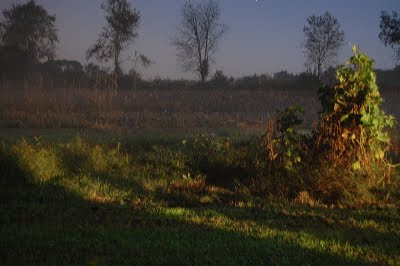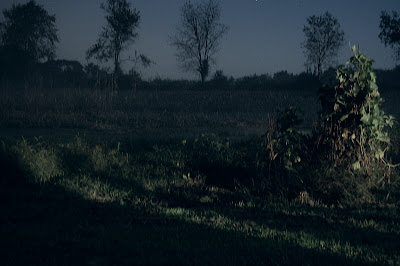We were at a friend's farm for the Chinese Moon Festival. Late in the evening, fog began to roll in, and the view toward the outbuildings was very fetching. I decided to try an available-light shot. With my camera (a Nikon D40) on no-flash Auto, I braced the camera against a chair and shot. The light behind me is from a large yard light that was turned on for some barbecuing. The camera made a two second exposure, and people I showed it to said it looked like a daylight picture:
 ISO 1600, f/4.5, 1.8sec, 31mm (50mm equiv).
ISO 1600, f/4.5, 1.8sec, 31mm (50mm equiv).The camera is programmed to gather light until the scene is "normally exposed", so I expected the image to look fully lit. However, it had not looked like this to the eye. I reduced the Gamma and blue-shifted it a little to get this rendering, which is much more like I recall it looking:

Then people began coming back from a moonlit walk in a mowed field, telling how pretty the fog looked. I went, and agreed, and using a table for a stand, found the camera did not want to take a picture. It could not focus. I switched it to Manual focus, and focused on the moon before setting the camera down to take this picture:
 ISO 1600, f/5, 10sec, 38mm (61mm equiv).
ISO 1600, f/5, 10sec, 38mm (61mm equiv).The lighted vine and grass in the foreground are lit by the yard light. The field beyond is moonlit. This doesn't look quite like a daylight image, but is brighter than what the eye sees. So I processed it to reduce the Gamma and blue-shift it, to get this image:

Here the fog is more visible over the field, because it scatters blue light better, so cutting some red enhanced it.
When the light is this dim, the eye doesn't see colors well. Moonlight is just bright enough to stimulate pseudocolor. That is, the most sensitive color pigment, green, works with the night vision pigment, which sees in the blue, to yield a blue-green sort of vision. The blue and green color pigments don't function at all.



No comments:
Post a Comment